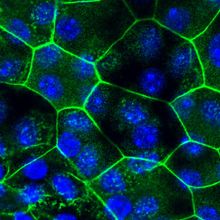Login
Subscribemicrobiology

Fungal Spores Hijack a Host Protein to Escape Death
Mariella Bodemeier Loayza Careaga, PhD | Jun 20, 2023 | 3 min read
Uncovering the components used by Aspergillus fumigatus to avoid intracellular destruction broadens our understanding of the mold’s pathogenesis.

How Bacterial Communities Divvy up Duties
Holly Barker, PhD | Jun 1, 2023 | 10+ min read
Biofilms are home to millions of microbes, but disrupting their interactions could produce more effective antibiotics.

The Scientist Speaks - Preventing the Next Pandemic With Organ Chips
Nele Haelterman, PhD | 1 min read
Don Ingber discusses how organ-on-a-chip technology helps identify, study, and combat viral variants that could cause the next pandemic.

A Not-So-Simple Idea
Niki Spahich, PhD | Jun 1, 2023 | 5 min read
A moonlit drive inspired the theory behind PCR. What did it take to make that wild idea reality?

Infographic: Stages of Biofilm Formation
Holly Barker, PhD | Jun 1, 2023 | 1 min read
Free-swimming bacteria settle on a surface to cooperate and form a protective biofilm.

The Advantages of 3-D Cell Culture
MilliporeSigma | 1 min read
3-D cell culture narrows the gap between in vitro and in vivo.

Self Sufficient Cells?
Katherine Irving | Jun 1, 2023 | 4 min read
Animal cells cannot produce 9 of the 20 amino acids they need to function. Some researchers are looking to change that.

Garbage to Guts: The Slow-Churn of
Plastic Waste
Iris Kulbatski, PhD | Jun 1, 2023 | 4 min read
The winding trail of environmental microplastics leads researchers to the human digestive ecosystem.

Are Your Cell Lines What You Think They Are?
MilliporeSigma | 1 min read
Learn how to identify contamination and authenticate your cell lines.

Cooperation and Cheating
Mariella Bodemeier Loayza Careaga, PhD | Jun 1, 2023 | 6 min read
Bacteria cooperate to benefit the collective, but cheaters can rig the system. How is the balance maintained?

Infographic: Curbing the Cheaters
Mariella Bodemeier Loayza Careaga, PhD | Jun 1, 2023 | 1 min read
From spatial structuring to policing, cooperative bacteria have a wide toolkit to contain the spread of cheaters.

Why Might Cells Die or Fail to Thrive in Culture?
MilliporeSigma | 1 min read
Learn more about cell culture best practices.

Gut Bacteria Contribute to Anorexia
Kamal Nahas, PhD | May 1, 2023 | 3 min read
Microbiomes transplanted from women with anorexia nervosa into mice enhanced symptoms of the eating disorder, such as rapid weight loss and reduced appetite.

Engineered Bacterial “Syringes” Can Deliver Drugs Into Human Cells
Rohini Subrahmanyam, PhD | Apr 20, 2023 | 4 min read
Researchers repurpose tiny bacterial injection systems to specifically inject a wide variety of proteins into human cells and living mice.

Wastewater’s Hidden Value for Monitoring Public Health
The Scientist and Bio-Rad Laboratories | 1 min read
Learn about wastewater-based epidemiology—from its conception to its present state and into its future.

Bladder ‘Memory’ Influences Urinary Tract Infection Recurrence in Mice
Alejandra Manjarrez, PhD | Apr 12, 2023 | 3 min read
Urinary tract infections leave permanent epigenetic marks in the mouse bladder epithelium, reprogramming its response to subsequent infections, a study finds.

“Cryptic Transcription”: How Aging Cells Express Fragments of Genes
Kamal Nahas, PhD | Apr 6, 2023 | 4 min read
Aging cells with weakened gene regulation spuriously transcribe RNAs, but their impact on health and longevity still needs to be examined.

Profiling Microbes in Their Environmental Context
The Scientist | 1 min read
In this webinar, an expert panel will discuss nucleic acid recovery and sequencing methods from biological samples found in unusual habitats.

Crystal-Clear Penicillin, 1945
Brittany McWilliams | Apr 3, 2023 | 4 min read
Political activist and Nobel winner Dorothy Crowfoot Hodgkin pioneered X-ray crystallography to discover the molecular structures of penicillin and insulin.

High-Resolution Microscope Watches Proteins Strut Their Stuff
Holly Barker, PhD | Mar 31, 2023 | 3 min read
Modification on a high-resolution fluorescent microscopy technique allow researchers to track the precise movements of motor proteins.